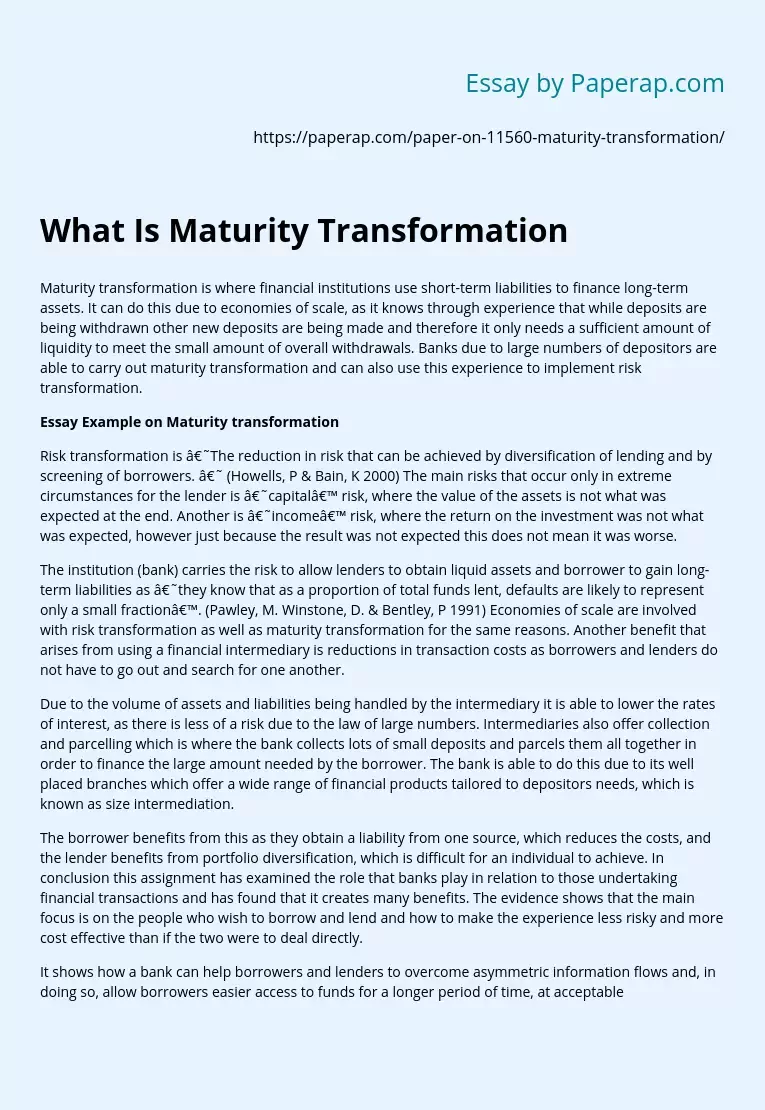What Is Maturity Transformation
Maturity transformation is where financial institutions use short-term liabilities to finance long-term assets. It can do this due to economies of scale, as it knows through experience that while deposits are being withdrawn other new deposits are being made and therefore it only needs a sufficient amount of liquidity to meet the small amount of overall withdrawals. Banks due to large numbers of depositors are able to carry out maturity transformation and can also use this experience to implement risk transformation.
Essay Example on Maturity transformation
Risk transformation is ‘The reduction in risk that can be achieved by diversification of lending and by screening of borrowers. ‘ (Howells, P & Bain, K 2000) The main risks that occur only in extreme circumstances for the lender is ‘capital’ risk, where the value of the assets is not what was expected at the end. Another is ‘income’ risk, where the return on the investment was not what was expected, however just because the result was not expected this does not mean it was worse.
The institution (bank) carries the risk to allow lenders to obtain liquid assets and borrower to gain long-term liabilities as ‘they know that as a proportion of total funds lent, defaults are likely to represent only a small fraction’. (Pawley, M. Winstone, D. & Bentley, P 1991) Economies of scale are involved with risk transformation as well as maturity transformation for the same reasons. Another benefit that arises from using a financial intermediary is reductions in transaction costs as borrowers and lenders do not have to go out and search for one another.
Due to the volume of assets and liabilities being handled by the intermediary it is able to lower the rates of interest, as there is less of a risk due to the law of large numbers. Intermediaries also offer collection and parcelling which is where the bank collects lots of small deposits and parcels them all together in order to finance the large amount needed by the borrower. The bank is able to do this due to its well placed branches which offer a wide range of financial products tailored to depositors needs, which is known as size intermediation.
The borrower benefits from this as they obtain a liability from one source, which reduces the costs, and the lender benefits from portfolio diversification, which is difficult for an individual to achieve. In conclusion this assignment has examined the role that banks play in relation to those undertaking financial transactions and has found that it creates many benefits. The evidence shows that the main focus is on the people who wish to borrow and lend and how to make the experience less risky and more cost effective than if the two were to deal directly.
It shows how a bank can help borrowers and lenders to overcome asymmetric information flows and, in doing so, allow borrowers easier access to funds for a longer period of time, at acceptable rates of interest, than if they dealt directly with the lenders. It can also allow lenders to gain a return on their excess of money at a lesser risk. Finally this essay found that the main ways that a financial institution (a bank) can do this is through processes such as Maturity transformation, Risk transformation, Reduction of transaction costs, and through Collection and Parcelling.
What Is Maturity Transformation. (2019, Nov 27). Retrieved from https://paperap.com/paper-on-11560-maturity-transformation/

